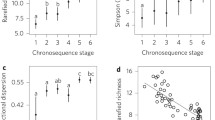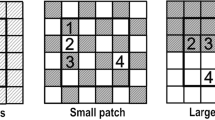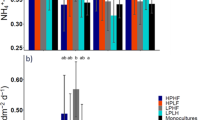Abstract
Most explanations for the positive effect of plant species diversity on productivity have focused on the efficiency of resource use, implicitly assuming that resource supply is constant. To test this assumption, we grew seedlings of Echinacea purpurea in soil collected beneath 10-year-old, experimental plant communities containing one, two, four, eight, or 16 native grassland species. The results of this greenhouse bioassay challenge the assumption of constant resource supply; we found that bioassay seedlings grown in soil collected from experimental communities containing 16 plant species produced 70% more biomass than seedlings grown in soil collected beneath monocultures. This increase was likely attributable to greater soil N availability, which had increased in higher diversity communities over the 10-year-duration of the experiment. In a distinction akin to the selection/complementarity partition commonly made in studies of diversity and productivity, we further determined whether the additive effects of functional groups or the interactive effects of functional groups explained the increase in fertility with diversity. The increase in bioassay seedling biomass with diversity was largely explained by a concomitant increase in N-fixer, C4 grass, forb, and C3 grass biomass with diversity, suggesting that the additive effects of these four functional groups at higher diversity contributed to enhance N availability and retention. Nevertheless, diversity still explained a significant amount of the residual variation in bioassay seedling biomass after functional group biomass was included in a multiple regression, suggesting that interactions also increased fertility in diverse communities. Our results suggest a mechanism, the fertility effect, by which increased plant species diversity may increase community productivity over time by increasing the supply of nutrients via both greater inputs and greater retention.

Similar content being viewed by others
References
Azcon R, Rubio R, Barea JM (1991) Selective interactions between different species of mycorrhizal fungi and Rhizobium meliloti strains, and their effects on growth, N2-fixation (15 N) and nutrition of Medicago sativa L. New Phytol 117:399–404
Balvanera P et al (2006) Quantifying the evidence for biodiversity effects on ecosystem functioning and services. Ecol Lett 9:1146–1156
Bartelt-Ryser J, Joshi J, Schmid B, Brandl H, Balser T (2005) Soil feedbacks of plant diversity on soil microbial communities and subsequent plant growth. Perspectives in plant ecology. Evol Syst 7:27–49
Ewel JJ, Mazzarino MJ, Berish CW (1991) Tropical soil fertility changes under monocultures and successional communities of different structure. Ecol Appl 1:289–302
Fargione J, Tilman D (2005) Diversity decreases invasion via both sampling and complementarity effects. Ecol Lett 8:604–611
Fargione J et al (2007) From selection to complementarity: shifts in the causes of biodiversity-productivity relationships in a long-term biodiversity experiment. Proc Biol Sci 274:871–876
Fornara DA, Tilman D (2008) Plant functional composition influences rates of soil carbon and nitrogen accumulation. J Ecol 96:314–322
Grigal DF, Chamberlain LM, Finney HR, Wroblewski DV, Gross ER (1974) Soils of the cedar creek natural history area. In: Miscellaneous report 123. University of Minnesota Agricultural Experiment Station, St. Paul
Gross K, Cardinale BJ (2007) Does species richness drive community production or vice versa? Reconciling historical and contemporary paradigms in competitive communities. Am Nat 170:207–220
Hector A, Bagchi R (2007) Biodiversity and ecosystem multifunctionality. Nature 448:188–191
Hooper DU et al (2005) Effects of biodiversity on ecosystem functioning: a consensus of current knowledge. Ecol Monogr 75:3–35
Huston MA (1997) Hidden treatments in ecological experiments: re-evaluating the ecosystem function of biodiversity. Oecologia 110:449–460
Huston MA, McBride AC (2002) Evaluating the relative strengths of biotic versus abiotic controls on ecosystem processes. In: Loreau M, Naeem S, Inchausti P (eds) Biodiversity and ecosystem functioning: synthesis and perspectives. Oxford University Press, Oxford, pp 47–60
Kinzig A, Pacala S, Tilman D (eds) (2002) The functional consequences of biodiversity. Princeton University Press, Princeton
Klironomos JN (2003) Variation in plant response to native and exotic arbuscular mycorrhizal fungi. Ecology 84:2292–2301
Knops JMH et al (1999) Effects of plant species richness on invasions dynamics, disease outbreaks, insect abundances, and diversity. Ecol Lett 2:286–293
Lanta V, Leps J (2007) Effects of species and functional group richness on production in two fertility environments: an experiment with communities of perennial plants. Acta Oecol 32:93–103
Lata H, De Andrade Z, Schaneberg B, Bedir E, Khan L, Moraes R (2003) Arbuscular mycorrhizal inoculation enhances survival rates and growth of micropropagated plantlets of Echinacea pallida. Planta Med 69:679–682
Loreau M (1998) Separating sampling and other effects in biodiversity experiments. Oikos 82:600–602
Loreau M, Hector A (2001) Partitioning selection and complementarity in biodiversity experiments. Science 412:72–76
Loreau M, Naeem S, Inchausti P (eds) (2002) Biodiversity and ecosystem functioning: synthesis and perspectives. Oxford University Press, Oxford
McKane RB, Grigal DF, Russelle MP (1990) Spatiotemporal differences in 15N uptake and the organization of an old-field plant community. Ecology 71:1126–1132
McKane RB et al (2002) Resource-based niches provide a basis for plant species diversity and dominance in artic tundra. Nature 415:68–71
Mitchell CE, Tilman D, Groth JV (2002) Effects of grassland plant species diversity, abundance, and composition on foliar fungal disease. Ecology 83:1713–1726
Mulder CPH, Jumpponen A, Hogberg P, Huss-Danell K (2002) How plant diversity and legumes affect nitrogen dynamics in experimental grassland communities. Oecologia 133:412–421
NADP (2007) NADP/NTN monitoring location MN01. In: NADP Program Office
Polley HW, Wilsey BJ, Tischler CR (2007) Species abundances influence the net biodiversity effect in mixtures of two plant species. Basic Appl Ecol 8:209–218
Poulton PR (1995) The importance of long-term trials in understanding sustainable farming systems: the Rothamsted experience. Aust J Exp Agric 35:825–834
Reich PB, Oleksyn J (2004) Global patterns of plant leaf N and P in relation to temperature and latitude. Proc Natl Acad Sci USA 101:11001–11006
Scherer-Lorenzen M, Palmborg C, Prinz A, Schulze ED (2003) The role of plant diversity and composition for nitrate leaching in grasslands. Ecology 84:1539–1552
Schimel JP, Bennett J (2004) Nitrogen mineralization: challenges of a changing paradigm. Ecology 85:591–602
Spehn EM et al (2005) Ecosystem effects of biodiversity manipulations in European grasslands. Ecol Monogr 75:37–63
Spehn EM et al (2002) The role of legumes as a component of biodiversity in a cross-European study of grassland biomass nitrogen. Oikos 98:205–218
Templer PH, Groffman PM, Flecker AS, Power AG (2005) Land use change and soil nutrient transformations in the Los Haitises region of the Dominican Republic. Soil Biol Biochem 37:215–225
Tilman D (1984) Plant dominance along an experimental nutrient gradient. Ecology 65:1445–1453
Tilman D, Hill J, Lehman C (2006) Carbon-negative biofuels from low-input high-diversity grassland biomass. Science 314:1598
Tilman D, Knops J, Wedin D, Reich P, Ritchie M, Siemann E (1997a) The influence of functional diversity and composition on ecosystem processes. Science 277:1300–1302
Tilman D, Lehman C, Thomson KT (1997b) Plant diversity and ecosystem productivity: theoretical considerations. Proc Natl Acad Sci USA 94:1857–1861
Tilman D, Reich PB, Knops J, Wedin D, Mielke T, Lehman C (2001) Diversity and productivity in a long-term grassland experiment. Science 294:843–845
Tilman D, Wedin D (1991) Plant traits and resource reduction for five grasses growing on a nitrogen gradient. Ecology 72:685–700
Tilman D, Wedin D, Knops J (1996) Productivity and sustainability influenced by biodiversity in grassland ecosystems. Nature 379:718–720
van der Heijden MGA, Bardgett RD, van Straalen NM (2008) The unseen majority: soil microbes as drivers of plant diversity and productivity in terrestrial ecosystems. Ecol Lett 11:296–310
van Ruijven J, Berendse F (2005) Diversity-productivity relationships: Initial effects, long-term patterns, and underlying mechanisms. Proc Natl Acad Sci 102:695–700
Waldrop MP, Zak DR, Blackwood CB, Curtis CD, Tilman D (2006) Resource availability controls fungal diversity across a plant diversity gradient. Ecol Lett 9:1127–1135
Wedin DA, Tilman D (1990) Species effects on nitrogen cycling: a test with perennial grasses. Oecologia 84:433–441
Wolf J, Johnson NC, Rowland DL, Reich PB (2003) Elevated CO2 and plant species richness impact arbuscular mycorrhizal fungal spore communities. New Phytol 157:579–588
Zak DR, Holmes WE, White DC, Peacock AD, Tilman D (2003) Plant diversity, soil microbial communities and ecosystem function: are there any links? Ecology 84:2042–2050
Acknowledgements
We thank T. Mielke, J. Hudgson, L. Spellen, C. Essenberg, and an intrepid crew of Cedar Creek interns for their help collecting these data, and we thank S. Hobbie and anonymous reviewers for comments that improved the manuscript. Funding for this project was provided by the National Science Foundation (NSF/DEB 0080382 and NSF/DEB 9629566) and the Andrew Mellon Foundation. This experiment complies with the current laws of the United States of America.
Author information
Authors and Affiliations
Corresponding author
Additional information
Communicated by Louis Pitelka.
Rights and permissions
About this article
Cite this article
Dybzinski, R., Fargione, J.E., Zak, D.R. et al. Soil fertility increases with plant species diversity in a long-term biodiversity experiment. Oecologia 158, 85–93 (2008). https://doi.org/10.1007/s00442-008-1123-x
Received:
Accepted:
Published:
Issue Date:
DOI: https://doi.org/10.1007/s00442-008-1123-x




